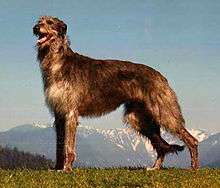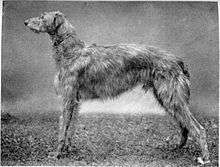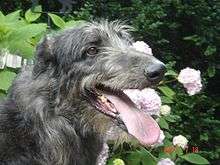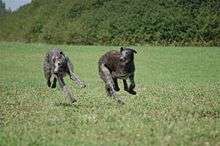Scottish Deerhound
The Scottish Deerhound, or simply the Deerhound, is a large breed of hound (a sighthound), once bred to hunt the red deer by coursing. In outward appearance, the Scottish Deerhound is similar to the Greyhound, but larger and more heavily boned with a rough-coat. The Deerhound is closely related to the Irish Wolfhound and was a contributor to that breed when it was re-created at the end of the 19th century.
| Scottish Deerhound | |||||||||||||||||||||||||||||||||
|---|---|---|---|---|---|---|---|---|---|---|---|---|---|---|---|---|---|---|---|---|---|---|---|---|---|---|---|---|---|---|---|---|---|
 | |||||||||||||||||||||||||||||||||
| Other names | Deerhound | ||||||||||||||||||||||||||||||||
| |||||||||||||||||||||||||||||||||
| |||||||||||||||||||||||||||||||||
| Dog (domestic dog) | |||||||||||||||||||||||||||||||||
History
The Hilton of Cadboll Stone dates from around 1,200 years ago, and depicts at the bottom of the panel a deer that is being chased by two large dogs and two armed horsemen.[3] However, systematic zooarchaeology and genetics have yet to show any connection between those symbolic representations of dog types and the modern breed, which only became widely known as the Scottish Deerhound distinct from regional greyhounds, such as the Highland greyhound or other staghounds in the early 19th century [4]
The Deerhound was bred to hunt red deer by “coursing” and “deer-stalking”[5][6] until the end of the 19th century. With modern rifles and smaller deer-forests, slower tracking dogs were preferred to fast and far-running Deerhounds. In coursing deer, a single Deerhound or a pair was brought as close as possible to red deer, then released to run one of them down by speed, which if successful would happen within a few minutes – rarely were there successful sustained chases.
With the eventual demise of the clan systems in Scotland, these hunting dogs became sporting animals for landowners and the nobility, but were also bred and hunted by common folk when feasible. As fast and silent hunters they made quick work of any game the size of a hare or larger and were highly regarded by nobility and poachers alike. One of the most precarious times in the breed's history seems to have been towards the end of the nineteenth century, when many of the large Scottish estates were split into small estates for sporting purposes, and few then kept Deerhounds. The new fashion was for stalking and shooting, which required only a tracking dog to follow the wounded animal, using a collie or similar breed. Although a few estates still employed Deerhounds for their original work, the breed was left in the hands of a few enthusiasts who made them a show breed.
Teddy Roosevelt wrote that some Canadian and American hunters used "the greyhound, whether the smooth-haired, or the rough-coated Scotch deer-hound" on the wolf[7] pp194-5, and deer[8]pp140-3 Dr. Q van Hummell also remarks on his Deerhound pack being used on timber wolves and coyotes.[9]pp185-7 In Australia, Deerhounds and their cross-breeds such as the Kangaroo Dog have historically been used to hunt the kangaroo as well as wild boar,[10] modern descriptions of such hunts with Deerhounds on kangaroo and emu have been recorded by Kenneth Cassels[11] pp71–100.
Description

In outward appearance, the Scottish Deerhound is similar to the Greyhound, but larger and more heavily boned. However, Deerhounds have a number of characteristics that set them apart. While not as fast as a Greyhound on a smooth, firm surface, once the going gets rough or heavy they can outrun a Greyhound. The environment in which they worked, the cool, often wet, and hilly Scottish Highland glens, contributed to the larger, rough-coated appearance of the breed. The Deerhound is closely related to the Irish Wolfhound and was a contributor to that breed when it was created at the end of the 19th century.
The Scottish Deerhound resembles a rough-coated greyhound. It is however, larger in size and bone. Height of males from 30 to 32 inches (75–80 cm) or more, weight 85 to 110 pounds (40–50 kg); height of females from 28 inches (70 cm) upwards, weight from 75 to 95 pounds (35–43 kg). It is one of the tallest sighthounds, with a harsh 3–4 inch long coat and mane, somewhat softer beard and moustache, and softer hair on breast and belly. It has small, dark "rose" ears which are soft and folded back against the head unless held semi-erect in excitement. The harsh, wiry coat in modern dogs is only seen in self-coloured various shades of gray (blue-gray is preferred). Historically, Deerhounds also could be seen with true brindle, yellow, and red fawn coats, or combinations. 19th century Scottish paintings tend to indicate these colours were associated with a wire haired coat, but, with show breeders preferring a longer coat, these genes now appear to be lost. A white chest and toes are allowed, and a slight white tip to the tail; a white blaze on the head or a white collar are not accepted. The head is long, skull flat, with little stop and a tapering muzzle. The eyes are dark, dark brown or hazel in colour. The teeth should form a level, complete scissor bite. The long straight or curved tail, well covered with hair, should almost reach the ground.
Temperament

The Scottish Deerhound is gentle and extremely friendly. The breed is famed for being docile and eager to please, with a bearing of gentle dignity. It is however a true sighthound which has been selected for generations to pursue game; consequently, most Deerhounds will be eager to chase. The Deerhound needs considerable exercise when young to develop properly and to maintain its health and condition. That does not mean it needs a large house to live in; however it should have regular access to free exercise in a fenced or otherwise "safe" area. Deerhounds should not be raised with access only to leash walking or a small yard, this would be detrimental to their health and development. City dwellers with conviction, however, can keep the dog both healthy and happy, as long as they are willing to take their Deerhounds to nearby parks for lengthy runs and rigorous fetching sessions within these wider running courses. Young Deerhounds can sometimes, depending on the individual, be quite destructive especially when they are not given sufficient exercise; however, the average adult Deerhound may want to spend most of the day stretched out on the floor or a couch sleeping. They do require a stimulus, preferably another Deerhound, and a large area to exercise properly and frequently[12] . They are gentle and docile indoors and are generally good around company and children (however, due to their size, they require supervision with young children).
Health

Longevity: the US health survey states 8.4 for males and 8.9 for females, the UK survey puts the average at 8.3 and median at 8.6. The serious health issues in the breed include cardiomyopathy; osteosarcoma; bloat; stomach or splenic torsion, called Gastric dilatation volvulus; and cystinuria. See current health studies.[1][2] Deerhounds like other sighthounds have unique anatomical and physiological features likely due to intentional selection for hunting by speed and sight. Laboratory studies have established reference intervals for haematology and serum biochemical profiles in Deerhounds some of which are shared by all sighthounds, some of which may be unique to this breed.[13]
Miscellaneous
Scottish Deerhounds compete throughout USA in conformation and lure coursing, in states where it is legal, they are used in hare coursing and for coyote hunting. Deerhounds can compete in obedience though few excel in it. Fewer still excel in dog agility or flyball because these competitions favor smaller dogs with lower body weight and a much shorter stride.
Notable Scottish Deerhounds
- A Scottish Deerhound named Foxcliffe Hickory Wind won Best In Show at the 2011 Westminster Kennel Club Dog Show on February 14–15, 2011.
- Maida was a crossbred Scottish Deerhound belonging to Sir Walter Scott.
- A Scottish Deerhound named Rhodry played Anne Lister's dog, Argus, in the TV show Gentleman Jack which starred Suranne Jones.
- A Scottish Deerhound named Cleod played the role of Padfoot, Sirius Black's canine Animagus form, in two films, Harry Potter and the Prisoner of Azkaban (2005) and Harry Potter and the Order of the Phoenix (2007).
- The Scottish Deerhound was the favorite dog breed of Danish writer Karen Blixen a.k.a. Isak Dinesen (1885–1962) during her years in East Africa (1914–31). The most cherished of them all was Dusk, with whom she can be seen in several photos.
See also
- List of domesticated Scottish breeds
References
- "Report from the Kennel Club/British Small Animal Veterinary Association Scientific Committee – Summary results of the Purebred Dog Health Survey for Deerhounds" (PDF). The Kennel Club. Archived from the original (pdf) on 2009-02-19. Retrieved 2009-01-20.
- "Health Problems of Scottish Deerhounds". Scottish Deerhound Club of America. Retrieved 2009-01-20.
- Hilton of Cadboll stone from the National Museum of Scotland
- Brown, T., 1829 Biographical sketches and authentic anecdotes of dogs
- Macrae, Alexander. A Handbook of Deer-stalking Edinburgh: William Blackwood 1880
- W. Bromley Davenport MP. "Sport". Retrieved 2009-01-20.
- Roosevelt, T., 1908 Hunting the grisly and other sketches New York
- Roosevelt, T. and Remington, F., 2009. Ranch life and the hunting trail. Courier Corporation.
- Shields, G. O. ed. 1891 The American book of the dog. The origin, development, special characteristics, utility, breeding, training, points of judging, diseases, and kennel management of all breeds of dogs
- Arthur, J.K., 1894 Kangaroo and Kauri: Sketches and Anecdotes of Australia and New Zealand
- Cassels, K.A.H., 1997 A Most Perfect Creature of Heaven: The Scottish Deerhound.
- "Deerhound Character".
- "Haematological and biochemical values in North American Scottish deerhounds. Sheerer et al Journal of Small Animal Practice 54(7) 354–360 2013".
Further reading
- Almirall, Leon V. Canines and Coyotes. Caldwell, Id.: The Caxton Printers, Ltd., 1941.
- Barret, Kay. Living with Deerhounds
- Bell, Weston. The Scottish Deerhound. 1892. (Reprinted by Hoflin Publishing Inc., 4401 Sephyr St., Wheat Ridge, Colorado, U.S.A. 80003.)
- Benbow, Audrey. How To Raise and Train A Scottish Deerhound. Neptune City, N.J.: T.F.H.Publications, 1965, 1993.
- Blaze, Elzear and Byng Hall, Herbert The Sportsman and His Dog London: Darling 1850
- Cassels, Kenneth. A Most Perfect Creature of Heaven: The Scottish Deerhound. K.A.H.Cassels, 1997.
- Crealock, Lt.-General Henry Hope. Deerstalking in the Highlands of Scotland. London: Longmans & Green, 1892.
- Cunliffe, Juliette. Deerhound. Dorking, Surrey, U.K.: Interpret Publishing, 2002.
- Cupples, George. Scotch Deerhounds and their Masters. Edinburgh: William Blackwood, 1892. (Reprinted in 1978 by Hoflin Publishing Inc.)
- Dalziel, Hugh. British Dogs – Their Varieties, History, Characteristics, Breeding, Management And Exhibition London: The Bazaar Office circa 1879
- Grimble, Augustus. Deer-stalking London: Chapman & Hall 1886
- Hartley, A.N. The Deerhound. 1986. (Available from the Scottish Deerhound Club of America and the Deerhound Club (U.K.))
- Heidenreich, Barbara. Your Scottish Deerhound Primer, Fern Hill, Ontario, 1989,1999,2005,2012.
- Macrae, Alexander. A Handbook of Deer-stalking Edinburgh: William Blackwood 1880
- Scrope, William. The Art of Deer-stalking. London: John Murray 1839.
- Shaw, Vero. The Illustrated Book of the Dog. London: Cassell 1881
- St. John, Charles. Sketches of the Wild Sports & Natural History of the Highlands London: John Murray 1878
- Van Hummell: "The Deerhound", in The American Book of the Dog Editor George O. Shields. Chicago: Rand Mcnally 1891
External links
| Wikimedia Commons has media related to Deerhound. |